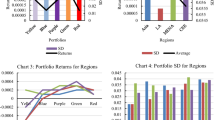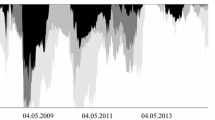Abstract
We investigate the linkage between business cycle convergence and financial portfolio choice for a panel of 18 EU countries. We construct an index of similarity of financial portfolios which we then put into context with the view that “the financial world” has an impact on business cycles and contributes to business cycle convergence via the consumption-wealth linkage. The model which guides our analysis is the International Asset Pricing Model (IAPM). Portfolios of the 18 EU countries investigated by us turn out to become more similar over time. According to our fixed effects GMM TSLS estimations, similar portfolios contribute to a convergence of business cycles—via a convergence of consumption cycles. This turns out to be especially true for country-pairs that include euro area non-member countries and, thus, have quite different income and wealth structures.





Similar content being viewed by others
Notes
Solnik (1974) in his intertemporal model differentiates between a hedged stock market portfolio and a risk free bond portfolio. The bond portfolio is only riskless with regard to its beta, not with regard to exchange rate risk. These two risky assets are summarized in this paper to the world market portfolio. The risk free asset is our usual risk free asset with a beta of 0 and no exchange rate risk.
Our final sample ranges from 2001 to 2006 although in same cases lagged variables, the latest from the year 2000, are used.
Exact data availability is mentioned in the text on a case-by-case basis in the respective sections.
This technique is based on a polynomial fit to the data with a weighted Least-squares method, according to which large residuals have less weight as small residuals to achieve higher variations not distorting the results. This is the main advantage of this visualization as opposed to the OLS procedure which is quite sensitive to outliers.
Results are available on request.
We would like to stress that a correlation of the endogenous variables with the error term is not a necessary precondition to use instrumental variable approaches. Nevertheless, it is a sufficient precondition.
References
Artis MJ (2003) Is there a European business cycle? CESifo Working Paper, 1053, CESifo, Munich
Baum CF (2006) An introduction to modern econometrics using stata. Stata Press, College Station
Baxter M, King RG (1999) Measuring business cycles: approximate band-pass filters for economic time series. Rev Econ Stat 81:575–593
Belke A, Heine JM (2006) Specialisation patterns and the synchronicity of regional employment cycles in Europe. Int Econ Econ Policy 3:91–104
Belke A, Heine JM (2007) On the endogeneity of an exogenous OCA-criterion: specialisation and the correlation of regional business cycles in Europe. Empirica 34:15–44
Bluethgen R, Hackethal A, Jansen C, Meyer S (2008) The cost of home bias: empirical evidence and implications for stock market participation. Working Paper, Oestrich-Winkel
Brooks R, Del Negro M (2004) The rise in comovement across national stock markets: market integration or IT bubble? J Empir Finance 11:659–680
Bundesverband deutscher Banken (2004) Das Sparverhalten in Europa ändert sich nur langsam. http://www.bankenverband.de/print.asp?artid=1235&channel=12121010. Date of retrieval: 27 May 2009
Clark TE, van Wincoop E (2001) Borders and business cycles. J Int Econ 55:59–85
Cleveland WS (1979) Robust locally weighted regression and smoothing scatterplots. J Am Stat Assoc 74:829–836
de Santis G, Gérard B (2006) Financial integration, international portfolio choice and the European monetary union. ECB Working Paper Series, 626. Frankfurt a.M
Greene WH (2003) Econometric analysis. Pearson Education, Upper Saddle River
Gros D, Hefeker C (2004) Asymmetric transmission of monetary policy: what should the ECB do if one size does not fit all? In: Sinn H, Widgrén M, Köthenbürger M (eds) European monetary integration. MIT Press, Cambridge, pp 45–63
Hill RC, Griffiths WE, Lim GC (2008) Principles of econometrics. Wiley, Hoboken
Hodrick RJ, Prescott EC (1997) Postwar U.S. business cycles: an empirical investigation. Journal of Money, Credit and Banking 29:1–16
Kishor KN (2007) Does consumption respond more to housing wealth than to financial market wealth? If so, why? J Real Estate Finance Econ 35:427–448
Lapp S (2001) Internationale Diversifikation in den Portfolios deutscher Kapitalanleger: Theorie und Empirie. Springer, Berlin
Ludwig A, Sløk T (2002) The impact of changes in stock prices and house prices on consumption in OECD countries. IMF Working Paper, 01/2002. Washington, DC
Mundell RA (1961) A theory of optimal currency areas. Am Econ Rev 51:657–665
Pesaran HM (2007) A simple panel unit root test in the presence of cross section dependence. J Appl Econ 22:265–312
Ravn MO, Uhlig H (2002) On adjusting the Hodrick-Prescott filter for the frequency of observations. Rev Econ Stat 84:371–376
Schneider J (2011) European business cycle convergence: portfolio similarity and a declining home bias of private investors. Mimeo, University of Hohenheim, Chair for International Economics, Stuttgart
Sharpe WF (1964) Capital asset prices: a theory of market equilibrium under conditions of risk. J Finance 19:425–442
Slacalek J (2006) What drives personal consumption?: the role of housing and financial wealth. DIW Discussion Paper, 647, Berlin
Solnik BH (1974) An equilibrium model of the international capital market. J Econ Theory 8:500–524
Sousa RM (2009) Wealth effects on consumption: evidence from the euro area. ECB Working Paper, 1050. Frankfurt a.M
StataCorp (2007) Stata statistical software, release 10: longitudinal/panel data. Stata Press, College Station
Uni Credit Group (2007) Global trends in the dynamic of household wealth and debt. http://www.ba-ca.com/informationspdfs/HOUSEHOLD_FIN_S_04_07.pdf. Date of retrieval: 2007-06-19.
von Nietzsch R, Stotz O (2006) Zu welchen Renditeeinbußen führt der Home Bias? Finanz Betrieb 8:106–113
Wooldridge JM (2002) Econometric analysis of cross section and panel data. The MIT Press, Cambridge
Zydra M (2008) Alles auf die Deutschland-Karte: Bundesbürger sparen vor allem national—was sehr riskant ist. Süddeutsche Zeitung, p 27
Author information
Authors and Affiliations
Corresponding author
Rights and permissions
About this article
Cite this article
Belke, A., Schneider, J. Portfolio choice of financial investors and European business cycle convergence: a panel analysis for EU countries. Empirica 40, 175–196 (2013). https://doi.org/10.1007/s10663-011-9181-4
Published:
Issue Date:
DOI: https://doi.org/10.1007/s10663-011-9181-4
Keywords
- Business cycle convergence
- Consumption-wealth linkage
- International asset pricing model
- Portfolio choice
- Panel methods
- Specialisation index




